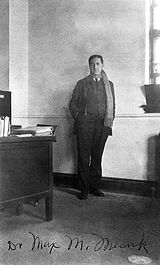Max Michael Munk (October 22, 1890 – June 3, 1986)[1] was a German aerospace engineer who worked for the National Advisory Committee for Aeronautics (NACA) in the 1920s and made contributions to the design of airfoils.
Education and early career
Munk earned an engineering degree from the Hannover Polytechnic School in 1914 and doctorates in both physics and mathematics from the University of Göttingen in 1918 with a dissertation on parametric studies of airfoils under Ludwig Prandtl. Munk's dissertation contained the nucleus of what would become airfoil theory.[2] After World War I, NACA (National Advisory Committee for Aeronautics, later to become NASA) brought Munk to the United States. President Woodrow Wilson signed orders allowing Munk to come to the United States and work in government. These orders were required since Germany was a recent enemy and Munk had worked briefly for the German Navy.
Career at NACA
Munk began work at NACA in 1920 and proposed building the new Variable Density Tunnel (VDT)[3] which went into operation in 1922. Munk published more than 40 articles with NACA.
Thin airfoil theory
Munk is best known for his development of thin airfoil theory, a means of modelling the behaviour of airfoils by separating their shape (the "mean camber line"[4]) and their varying thickness.[5] This allows separate, and simpler, techniques to model each behaviour. Lift may be assumed to depend on the camber (and angle of attack) alone, and could be modelled by the numerical techniques of the period. Drag depends on the thickness and requires an understanding of viscous flow, which was beyond contemporary capabilities. The thin airfoil technique was introduced in 1922 and remained the major theoretical design technique until the development of laminar flow airfoils in the 1930s.[6]
References
- ^ Anderson, John David (1999). A history of aerodynamics and its impact on flying machines. Cambridge University Press. p. 290. ISBN 0-521-66955-3. Retrieved July 21, 2010.
- ^ Eckert, Michael (2007). The Dawn of Fluid Dynamics: A Discipline Between Science and Technology. Wiley.
- ^ "The Variable-Density Wind tunnel". NASA.
- ^ "Mean camber line" is a conceptual curved line drawn through the mean centre of the airfoil, equally spaced from the upper and lower surfaces
- ^ Distribution of thickness across the chord, i.e. from front to back of the airfoil
- ^ Vincenti, Walter G. (1990). What engineers know and how they know it. Baltimore: Johns Hopkins University Press. pp. 36–39. ISBN 0-8018-4588-2.
See also
- Report of James and Judith Barrowman
Further reading
- Gorn, Michael H. (13 August 2001). Expanding the envelope: Flight Research at NACA and NASA. ISBN 0-8131-2205-8.
